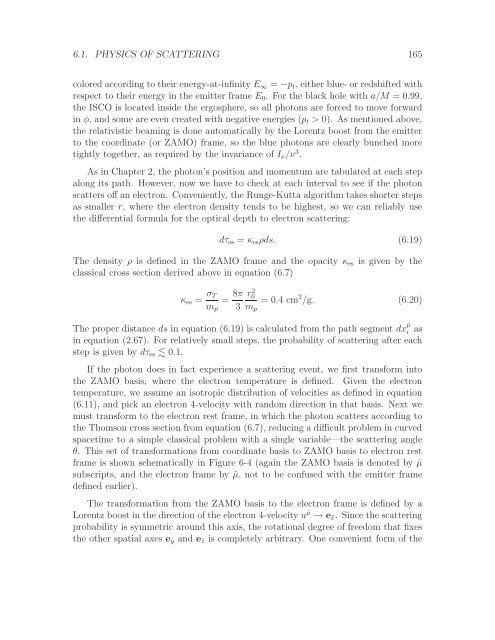Radiation Transport Around Kerr Black Holes Jeremy David ...
Radiation Transport Around Kerr Black Holes Jeremy David ...
Radiation Transport Around Kerr Black Holes Jeremy David ...
You also want an ePaper? Increase the reach of your titles
YUMPU automatically turns print PDFs into web optimized ePapers that Google loves.
6.1. PHYSICS OF SCATTERING 165<br />
colored according to their energy-at-infinity E ∞ = −p t , either blue- or redshifted with<br />
respect to their energy in the emitter frame E 0 . For the black hole with a/M = 0.99,<br />
the ISCO is located inside the ergosphere, so all photons are forced to move forward<br />
in φ, and some are even created with negative energies (p t > 0). As mentioned above,<br />
the relativistic beaming is done automatically by the Lorentz boost from the emitter<br />
to the coordinate (or ZAMO) frame, so the blue photons are clearly bunched more<br />
tightly together, as required by the invariance of I ν /ν 3 .<br />
As in Chapter 2, the photon’s position and momentum are tabulated at each step<br />
along its path. However, now we have to check at each interval to see if the photon<br />
scatters off an electron. Conveniently, the Runge-Kutta algorithm takes shorter steps<br />
as smaller r, where the electron density tends to be highest, so we can reliably use<br />
the differential formula for the optical depth to electron scattering:<br />
dτ es = κ es ρds. (6.19)<br />
The density ρ is defined in the ZAMO frame and the opacity κ es is given by the<br />
classical cross section derived above in equation (6.7)<br />
κ es = σ T<br />
m p<br />
= 8π 3<br />
r 2 0<br />
m p<br />
= 0.4 cm 2 /g. (6.20)<br />
The proper distance ds in equation (6.19) is calculated from the path segment dxˆµ i as<br />
in equation (2.67). For relatively small steps, the probability of scattering after each<br />
step is given by dτ es 0.1.<br />
If the photon does in fact experience a scattering event, we first transform into<br />
the ZAMO basis, where the electron temperature is defined. Given the electron<br />
temperature, we assume an isotropic distribution of velocities as defined in equation<br />
(6.11), and pick an electron 4-velocity with random direction in that basis. Next we<br />
must transform to the electron rest frame, in which the photon scatters according to<br />
the Thomson cross section from equation (6.7), reducing a difficult problem in curved<br />
spacetime to a simple classical problem with a single variable—the scattering angle<br />
θ. This set of transformations from coordinate basis to ZAMO basis to electron rest<br />
frame is shown schematically in Figure 6-4 (again the ZAMO basis is denoted by ˆµ<br />
subscripts, and the electron frame by ˜µ, not to be confused with the emitter frame<br />
defined earlier).<br />
The transformation from the ZAMO basis to the electron frame is defined by a<br />
Lorentz boost in the direction of the electron 4-velocity uˆµ → e˜x . Since the scattering<br />
probability is symmetric around this axis, the rotational degree of freedom that fixes<br />
the other spatial axes eỹ and e˜z is completely arbitrary. One convenient form of the
















